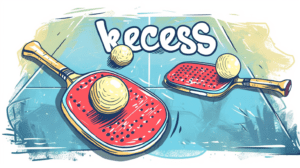How to get a pickleball rating – Quick Guide
Last updated

Getting a pickleball rating is a great step if you’re passionate about the game. Think of your rating as a badge of your hard work, a measure of your skill, and a way to find games that really match your level.
Knowing how to get a pickleball rating can significantly enhance your game. By understanding the ins and outs, you can work on bumping up your rating to better reflect your true pickleball skills.
KEY TAKEAWAYS
What Is The Purpose of a Pickleball Rating?
A pickleball rating underpins your journey in the sport by serving a dual purpose: it benchmarks your skill while ensuring you face opponents that match your competitive level. This rating scale helps organize players, making sure that games are fair and challenging for everyone involved.
An Overview of Self-Rating and Tournament-Based Ratings
Starting off, you’ll give yourself a rating by comparing your skills to standard criteria, much like using a pickleball skill calculator. This helps you understand where you’re at in terms of development. But to get a truly objective measure of your ability, tournament-based ratings are key.
These are based on how you perform in official matches, offering a clear indication of where you stand in the sport. Participating in tournaments is a crucial way to test and hone your skills, and it’s vital in shaping your official competitive rating.
Decoding the Rating Scale: From 1.0 to 5.5+
Understanding the pickleball rating scale is like decoding a language that speaks of your prowess on the court. Ratings range from 1.0 for beginners all the way to 5.5+ for players of a professional calibre.
Transitioning from self-assessment to a tournament-validated rating can move you through these levels, where each incremental step signifies a closer reach toward mastery of the game.
So, as you lace up your sneakers and head out to play, keep in mind how each volley, dink, and serve could contribute to climbing the rating scale and enhancing your stature in the pickleball community.
For more insight into how these ratings are calculated and what they mean for your game, check out our guide on decoding your pickleball rating.
Starting with Self-Rating: Know Your Own Skill Level
When you dive into your pickleball adventure, the first step is to take a good look at your own game. It’s about knowing what you’re good at and what needs work.
This doesn’t just give you a clear starting point, but it also helps direct your growth as a player.
So, let’s kick things off by assessing your skills and seeing how they stack up against the known benchmarks for pickleball self-ratings.
Evaluating Your Physical and Strategic Abilities
Break down your game into its physical components: how is your forehand, backhand, and serve? Reflect on your volleying techniques and the strategies you employ during gameplay.
Accurate self-assessment of these skills against the background of pickleball rules is crucial, as it sets the tone for your progression and readiness for competitive play.
By understanding where you stand, you can set realistic goals for enhancing your strategic abilities.
Using USA Pickleball’s Skill Assessment Sheets for Guidance
USA Pickleball’s skill assessment sheets are invaluable tools in your self-rating process. They outline the capabilities expected at each level, helping you to gauge where your skills fit within the spectrum from novice 1.0 to the refined prowess of a 5.0 player.
Utilize these guidelines to benchmark your current abilities and pinpoint the areas where focused training can elevate your gameplay and pickleball skill assessment.
Transitioning from Self-Rating to UTPR
When you’re ready to take your self-rated evaluation and test it in the competitive arena, the transition to the UTPR (USA Pickleball Tournament Player Ratings) system is your next move. Unlike the broad brush of self-ratings, UTPR offers a nuanced 4-digit rating reflective of your performance in sanctioned tournaments.
This not only confirms your competitive level but also opens doors to matches that will challenge and improve your strategic gameplay.
How to Get a Pickleball Rating: Official Methods
Suppose you’re committed to enhancing your pickleball prowess. In that case, it’s essential to understand the two principal channels for obtaining an official pickleball rating. These official methods evaluate your gameplay more accurately than self-assessments and are recognized across the pickleball community.
The first method involves participating in USA Pickleball-sanctioned tournaments. These competitive events are critical for determining your USA Pickleball Tournament Player Rating (UTPR), a rating system that meticulously tracks your tournament outcomes. Each match you play in these tournaments contributes to a sophisticated algorithm that calculates your UTPR, solidifying your standing within the official pickleball community.
Alternatively, I suggest you want a more holistic reflection of your skillset. In that case, the Dynamic Universal Pickleball Rating (DUPR) might be your preferred choice. Unlike UTPR, DUPR avails itself to a wider arena, capturing data from both sanctioned events and casual play, such as leagues or friendly matches.
This rating system pays close attention to the score differentials and the nature of each match, offering a dynamic and evolving depiction of your pickleball capabilities.
When deciding between these rating systems, consider your commitment to pickleball. Are you aiming for the professional tiers and focusing solely on sanctioned tournaments? Or do you prefer a system like DUPR that accommodates the breadth of your play, including those fun yet competitive park pickup games?
Your choice should align with where you place your competitive focus and how you want your progress and skill development tracked and quantified.
USA Pickleball Tournament Player Ratings (UTPR) Explained
If you’ve been immersed in the world of pickleball, understanding the ins and outs of the official pickleball rating system, especially the USA Pickball Tournament Player Ratings (UTPR), is essential for mapping your tournament journey.
What Counts Towards Your UTPR?
When you start playing competitively, a big part of your attention will likely be on accumulating results in tournaments that affect your UTPR (Universal Tennis Rating). It’s important to remember that your skill in casual or recreational matches doesn’t influence your official UTPR.
Only your performance in events sanctioned by USA Pickleball is taken into account. This focused approach ensures that your UTPR is a true reflection of your ability to handle competitive pressure and serves as proof of your commitment and skill in pickleball.
Understanding the Significance of 2-Digit and 4-Digit Ratings
Grasping the difference between 2-digit and 4-digit ratings can be a game-changer for your tournament experience. The 2-digit rating, your broader classification, places you in categories that define your general competitive tier.
Meanwhile, the more precise 4-digit rating influences crucial aspects like tournament seeding, ensuring a fair and strategic lineup.
To see where you stand, participate in USA Pickleball-sanctioned tournaments and check your USAPA member profile—you’ll discover where your UTPR has ranked you in the exciting world of pickleball.
DUPR: The Dynamic Universal Pickleball Rating System
Having a system like the Dynamic Universal Pickleball Rating (DUPR) is a game-changer. Launched in 2021, DUPR offers a fresh perspective on measuring pickleball ability, considering your performance across various match types, from relaxed recreational games to intense tournament play.
DUPR stands out for its detailed approach. Unlike traditional rating systems that mainly focus on wins and losses, DUPR dives into the nuances, looking at score differences and the specific circumstances of each match. This gives a more accurate and holistic view of your playing level.
The pickleball community is taking note, especially with endorsements from Major League Pickleball, signalling DUPR’s significance in setting new standards for skill assessment. The convenience of a mobile app for logging matches further enhances its appeal, keeping players connected to their progress.
While newer than some established systems, DUPR’s inclusive and thorough methodology is rapidly gaining traction. It caters to everyone from casual players seeking to spice up their game to professionals aiming for the top, making it an exciting tool for tracking and improving your pickleball skills.
Improving Your Pickleball Rating: Tips and Strategies
Improving your pickleball skills is key to advancing in the sport, whether your goal is to shine in local games or to make a mark in prestigious tournaments. Working on enhancing your pickleball rating is a journey that demands a strong commitment to developing your gameplay. Climbing up the rating ladder involves refining your techniques, deepening your understanding of the game, and maintaining physical fitness.
Key Skills to Master for Each Rating Level
Understanding the progression of skills required at each level serves as a cornerstone for your development. Focus on enhancing aspects such as serve speed, precision in your dink shots, and a tactical approach to volleying.
For beginner players aiming to improve beyond the 1.0 level, developing a reliable serve and gaining a fundamental understanding of the rules are essential. On the other hand, if you’re approaching the 4.0 threshold, your goals should include maintaining a consistent volley exchange and constructing points with intent.
Mindset and Consistency in Practice and Tournaments
A disciplined mindset, twinned with consistent practice, is the scaffold that supports your ambitions of a higher rating. The mental game in pickleball can’t be overstated; nurturing resilience and focus during match play creates the fortitude required to confront the pressures of tournament environments.
Integrate consistent practice into your routine to reinforce your strengths and address your weaknesses. This will prepare you for the varied scenarios you’ll encounter on the court and facilitate skill transfer from practice sessions to actual matches.
Applying Strategy and Adaptability in Matches
Smart play, an eye for your opponent’s vulnerabilities, and the capacity to adjust your strategy on the fly often spell the difference between a stagnant rating and a notable jump.
Analyze your opponents, predict their moves, and vary your shots to maintain the upper hand.
By embracing adaptability and strategic diversity in your gameplay, you are more apt to overcome a challenging opponent and improve your pickleball rating.
Resources
“Definitions of Player Skill Ratings.” USA Pickleball – America’s Fastest Growing Sport, USA Pickleball, https://usapickleball.org/tournaments/tournament-player-ratings/player-skill-rating-definitions/.
“How to Find Your Pickleball Rating.” PPA Tour, https://www.ppatour.com/how-to-find-your-pickleball-rating/.







